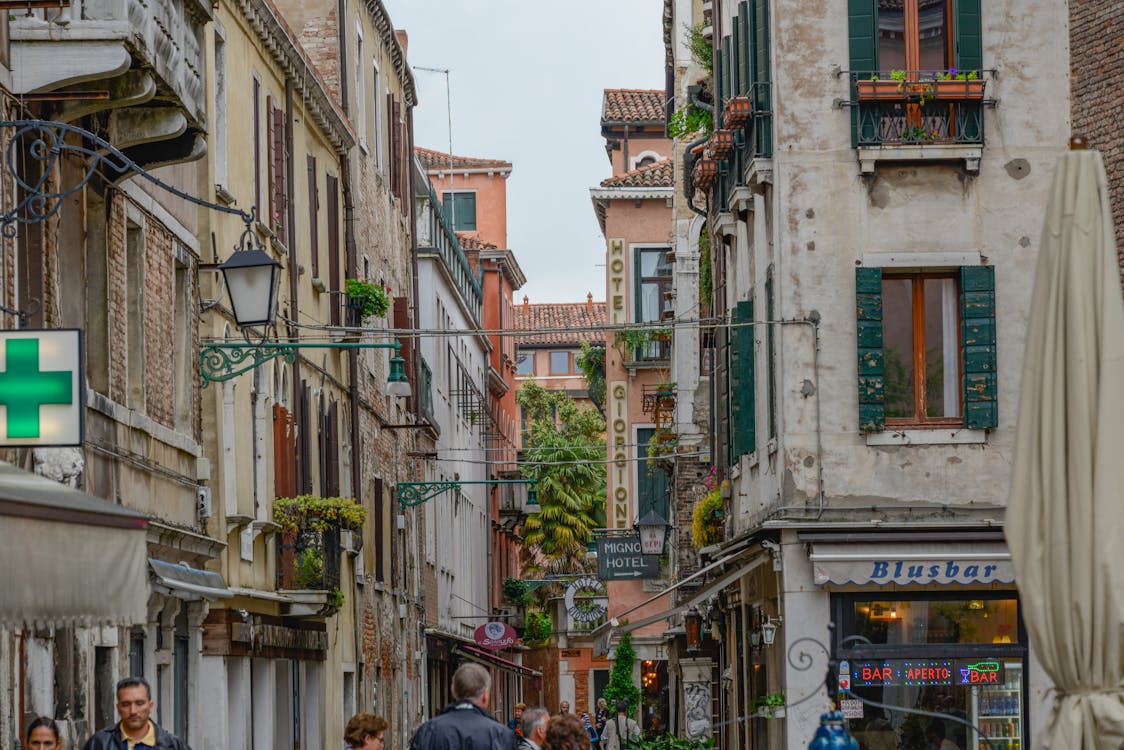Traveling to Italy from Germany is an exciting journey that combines the best of two of Europe’s most iconic destinations. Germany, with its blend of modern cities, medieval charm, and lush countryside, offers a unique starting point.
Meanwhile, Italy captivates with its ancient ruins, Renaissance masterpieces, and stunning coastlines.
This blog aims to guide travelers on the best ways to journey from Germany to Italy, providing valuable transportation tips to ensure a smooth and enjoyable trip.
Choosing Your Perfect Route
Selecting the optimal route can significantly enhance your travel experience when planning your trip from Germany to Italy. After all, Italy is one of the best places to visit in Europe.
Flying
Flying is often the fastest and most convenient way to travel between Germany and Italy, offering numerous daily connections between major cities.
Pros and Cons
Here are some key advantages and disadvantages of choosing to fly from Germany to Italy:
- Pros:
- Speed: Flying is the fastest way to travel between Germany and Italy, with flight times typically ranging from 1.5 to 2 hours.
- Convenience: Direct flights between major cities allow for easy and quick transit.
- Cons:
- Cost: Air travel can be more expensive than other transport modes.
- Potential Flight Limitations: Airports may be located far from city centers, requiring additional transportation.
Major Airlines Serving the Route
Several major airlines operate flights between Germany and Italy, making it easy for travelers to find a convenient option.
- Lufthansa
- Alitalia
- Ryanair
- easyJet
- Eurowings
Finding the Best Deals on Flights
Various factors must be considered when searching for the best deals on flights from Germany to Italy to ensure the most value.
- Compare prices using flight aggregator websites like Skyscanner, Kayak, or Google Flights.
- Book in advance to secure lower fares.
- Consider low-cost carriers such as Ryanair and easyJet for budget-friendly options.
Top Airports in Germany and Italy
When traveling between Germany and Italy, choosing the right airport can greatly influence the ease and enjoyment of your journey.
- Germany:
- Frankfurt Airport (FRA)
- Munich Airport (MUC)
- Berlin Brandenburg Airport (BER)
- Italy:
- Rome Fiumicino Airport (FCO)
- Milan Malpensa Airport (MXP)
- Venice Marco Polo Airport (VCE)
Train Travel
Train travel offers a unique and comfortable alternative to flying if you prefer a more scenic and leisurely journey between Germany and Italy.
Pros and Cons
Train travel between Germany and Italy provides a scenic and relaxing way to enjoy the journey while experiencing the picturesque landscapes of Europe.
- Pros:
- Scenic Journeys: Train travel offers picturesque countryside and Alps views.
- Comfortable Travel: Spacious seating and amenities make for a pleasant journey.
- Cons:
- Slower Travel Times: Trains can take longer than flights, ranging from 7 to 10 hours.
- Limited Routes: Not all destinations may be directly connected by train.
Major Train Routes Between Germany and Italy
Train travel between Germany and Italy offers several major routes that connect key cities in both countries.
- Munich to Rome
- Frankfurt to Milan
- Berlin to Venice
Eurail Pass Options
The Eurail Pass offers a flexible and convenient way to explore multiple destinations across Germany and Italy by train.
- A Eurail pass allows unlimited travel on most European trains for a set period, offering good value for those planning multiple trips.
Booking Train Tickets
Booking train tickets for travel between Germany and Italy is straightforward. Tickets can be booked online or at train stations.
- Websites: Deutsche Bahn (DB), Trenitalia, Eurail
- Apps: Trainline, Omio
Bus Travel
Bus travel offers a cost-effective alternative to trains and flights if you are looking for a budget-friendly option to travel between Germany and Italy.
Pros and Cons
Bus travel between Germany and Italy provides an economical yet slower alternative for those on a budget.
- Pros:
- Budget-Friendly: Buses are often the cheapest travel option.
- Good for City Connections: Extensive routes connect many city centers directly.
- Cons:
- Longer Travel Times: Bus journeys can be lengthy, ranging from 10 to 20 hours.
- Less Comfort: Buses may lack the comfort and amenities of trains or flights.
Popular Bus Routes Between Germany and Italy
Travelers have several popular bus routes when journeying between Germany and Italy.
- Berlin to Milan
- Munich to Venice
- Frankfurt to Florence
Booking Bus Tickets
Booking bus tickets for travel between Germany and Italy is easy. Tickets can be booked through various online platforms and at bus terminals.
- Websites: FlixBus, Eurolines
- Apps: FlixBus, Omio
Driving
Driving between Germany and Italy allows you to travel freely and explore more remote areas. You can also rent a car in Italy for your convenience.
Pros and Cons
Driving between Germany and Italy offers the flexibility to create your itinerary and enjoy the scenic routes at your own pace.
- Pros:
- Flexibility: Drive at your own pace and make detours to explore off-the-beaten-path locations.
- Road Trip Opportunities: Enjoy scenic drives through the Alps or the Austrian countryside.
- Cons:
- Potential Challenges: Navigation, tolls, and unfamiliar driving rules can be challenging.
- Costs: Fuel, tolls, and potential rental fees can add up.
Recommended Routes for Driving from Germany to Italy
For those considering a road trip between Germany and Italy, several scenic and efficient routes can enhance your travel experience.
- Take the A22 motorway through Austria and the Brenner Pass into northern Italy.
- Drive through the Austrian Alps and Timmelsjoch High Alpine Road for a scenic route.
Important Considerations for Driving
When planning to drive from Germany to Italy, there are several important considerations to remember to ensure a smooth and enjoyable journey.
- Car Rentals: Rent from reputable companies and check for cross-border travel policies.
- International Driving Permit: Depending on your country of origin, you may need an IDP.
- Tolls: Be prepared for toll roads, especially in Italy.
- Road Signs: Familiarize yourself with European road signs and driving rules.
Choosing the perfect route from Germany to Italy depends on your travel preferences, budget, and schedule. Whether you opt for the speed of flying, the scenic pleasure of trains, the affordability of buses, or the adventurous spirit of a road trip, each option offers unique experiences to enhance your journey.
Planning Your Trip to Italy
Planning a memorable trip to Italy involves carefully considering various factors to ensure an enjoyable and hassle-free experience.
Visa Requirements
Before traveling to Italy from Germany, it’s crucial to understand the visa requirements:
- Schengen Visa: Most European nationalities, including German citizens, do not need a visa for short stays in Italy (up to 90 days) as both countries are part of the Schengen Area. Check if a Schengen visa is required for non-European nationals and apply accordingly.
Travel Costs
Planning your budget is essential for a smooth trip. Here’s a rough estimate of costs associated with different travel options:
Flights
Flights can quickly and conveniently travel from Germany to Italy, saving time and effort.
- Cost: €50-€200 one-way, depending on the airline and booking time.
- Tips: Book in advance, use flight aggregators, and consider low-cost carriers.
Trains
Traveling by train offers a scenic and comfortable journey from Germany to Italy, allowing you to enjoy the picturesque landscapes along the route.
- Cost: €70-€150 one-way for high-speed trains.
- Tips: Book tickets early on websites like Deutsche Bahn or Trenitalia, and consider a Eurail pass for multiple trips.
Buses
Buses provide an economical and flexible option for traveling between Germany and Italy, making them ideal for budget-conscious travelers.
- Cost: €30-€80 one-way.
- Tips: Look for deals on bus company websites (FlixBus, Eurolines) and book in advance.
Driving
Driving from Germany to Italy can be an adventurous and flexible way to explore multiple destinations at your own pace.
- Cost: Fuel (€100-€200), tolls (€20-€50), car rental (€30-€70 per day).
- Tips: Share costs if traveling with others, plan for tolls, and check car rental policies for cross-border travel.
Best Time to Travel
Choosing the right time to travel can enhance your experience:
Weather
Choosing the perfect time to visit Italy ensures you experience the best that this beautiful country has to offer.
- Spring (April to June): Mild weather and blooming landscapes make it an ideal time.
- Summer (July to August): It’s warm and sunny, but it’s also peak tourist season, so expect crowds and higher prices.
- Fall (September to October): Pleasant temperatures and fewer tourists.
- Winter (November to March): Colder weather but great for visiting cities and enjoying winter sports in the Alps.
Peak Tourist Seasons
Several factors must be considered when planning a trip from Germany to Italy to ensure a smooth and enjoyable journey.
- High Season: Summer (June to August) and major holidays.
- Low Season: Winter months (excluding Christmas and New Year).
Events/Festivals
Discovering Italy’s vibrant events and festivals can add a culturally rich dimension to your travel experience.
- Carnival of Venice: February/March.
- Milan Fashion Week: February and September.
- Verona Opera Festival: June to September.
Packing Essentials
Packing efficiently ensures you’re prepared for your journey and the destination’s climate:
For Flights
When packing for a flight, it is essential to consider both convenience and the unpredictable nature of travel.
- Essentials: Passport, tickets, ID, travel insurance, and any necessary visas.
- Comfort Items: Neck pillow, headphones, and entertainment (books, tablets).
For Train Travel
Train travel offers a scenic and relaxing way to traverse Italy’s picturesque landscapes.
- Essentials: Tickets, passports, snacks, and water.
- Comfort Items: Blankets, reading material, and a charger for electronics.
For Bus Travel
Exploring Italy by bus provides an affordable and flexible way to experience the country’s diverse regions and attractions.
- Essentials: Tickets, passports, snacks, and water.
- Comfort Items: Travel pillow, earplugs, and entertainment.
For Driving
Driving in Italy allows for unparalleled freedom to explore the country’s charming towns and stunning countryside at your own pace.
- Essentials: Driver’s license, International Driving Permit (if required), car documents, and a GPS or map.
- Comfort Items: Snacks, water, sunglasses, and a first aid kit.
Seasonal Clothing
Packing the right seasonal clothing is crucial to ensure comfort and suitability for the weather during your trip.
- Spring/Fall: Layered clothing, light jacket, comfortable walking shoes.
- Summer: Light clothing, sunscreen, hat, and sunglasses.
- Winter: Warm clothing, waterproof jacket, gloves, and scarves.
By carefully planning your trip, considering visa requirements, estimating costs, choosing the best time to travel, and packing appropriately, you’ll be well-prepared to make the most of your adventure from Germany to Italy.
Making the Most of Your Journey
Traveling from Germany to Italy promises many unforgettable experiences and diverse attractions that cater to every type of traveler.
Interesting Stops and Day Trips
Depending on your chosen route from Germany to Italy, several fascinating stops and day trips can enrich your travel experience:
Driving: Exploring the Austrian Alps
The journey from Germany to Italy offers the perfect opportunity to explore the Austrian Alps’s stunning beauty and cultural gems.
- Zugspitze: Germany’s highest peak, offering stunning views and hiking opportunities.
- Innsbruck, Austria: A charming city in the Austrian Alps, perfect for a scenic stopover with attractions like the Golden Roof and the Nordkette cable car.
- Brenner Pass: This historic mountain pass offers breathtaking views and is a gateway to Italy.
Train Travel: Visiting Historical Towns
Traveling by train from Germany to Italy allows you to experience charming towns’ rich history and picturesque scenery.
- Munich to Rome:
- Salzburg, Austria: Birthplace of Mozart and a UNESCO World Heritage Site, known for its baroque architecture and beautiful gardens.
- Verona, Italy: Famous for Juliet’s balcony from Shakespeare’s “Romeo and Juliet” and its well-preserved Roman Arena.
- Frankfurt to Milan:
- Basel, Switzerland: A cultural hub with numerous museums and art galleries.
- Lucerne, Switzerland: Known for its medieval architecture and the stunning backdrop of Lake Lucerne and the Swiss Alps.
Bus Travel: Exploring City Connections
Bus travel from Germany to Italy provides an economical and flexible way to explore the vibrant connections between key cities.
- Berlin to Milan:
- Nuremberg, Germany: Rich in history with its medieval castle and vibrant old town.
- Zurich, Switzerland: A major financial center with a picturesque old town and beautiful lake views.
- Munich to Venice:
- Bolzano, Italy: The gateway to the Dolomites, offering a blend of Italian and Austrian cultures.
- Lake Garda: Italy’s largest lake, perfect for a relaxing break with charming lakeside towns.
Landmarks and Must-See Attractions Near Travel Routes
Whether you’re flying, taking the train, or driving, don’t miss these landmarks and attractions near your travel routes:
By Air
Exploring the skies offers a unique vantage point and the convenience of rapid travel while still allowing the chance to discover stunning landmarks.
- Rome:
- Colosseum: One of the greatest works of Roman architecture and engineering.
- Vatican City: Home to St. Peter’s Basilica, the Sistine Chapel, and the Vatican Museums.
- Milan:
- Duomo di Milano: An iconic Gothic cathedral in the heart of Milan.
- Santa Maria delle Grazie: Houses Leonardo da Vinci’s famous mural, “The Last Supper.”
By Train
Train travel offers a scenic and comfortable way to explore Europe’s rich cultural heritage.
- Munich:
- Neuschwanstein Castle: A fairy-tale castle near Munich, an easy day trip.
- English Garden: One of the largest urban parks in the world.
- Venice:
- St. Mark’s Basilica: Renowned for its opulent design and golden mosaics.
- Grand Canal: The main waterway of Venice, lined with stunning buildings.
By Car
Exploring by car offers the flexibility to journey at your own pace and discover hidden gems.
- Florence:
- Uffizi Gallery: One of the most famous art museums, housing works by Michelangelo, da Vinci, and Botticelli.
- Ponte Vecchio: A medieval stone bridge with shops built along it.
- Tuscany:
- Siena: Known for its medieval cityscape and the Palio horse race.
- Chianti Region: Famous for its vineyards and wine-tasting tours.
Enhancing your journey with these interesting stops and must-see attractions will not only break up the travel time but also provide you with unforgettable experiences and insights into the rich culture and history of the regions you’re passing through.
Wrapping Up
Planning your trip from Germany to Italy involves choosing the best route, understanding visa requirements, budgeting travel costs, and packing essentials for your transportation mode.
Whether you fly, take a scenic train, a budget-friendly bus, or drive through picturesque landscapes, each method offers unique experiences and memorable stops.
Arriving in Italy after a well-planned journey is thrilling and marks the start of new adventures. Italy offers cultural, gastronomic, and scenic delights, from the historical treasures of Rome to the artistic wonders of Florence and the romantic canals of Venice.
Embrace the excitement of exploring this beautiful country, knowing your preparations have set the stage for an unforgettable travel experience.
The takeaway
So, there you have it! Your ultimate guide to hopping over from Mykonos to Paros. Remember, whether it’s a quick 40-minute dash or a more relaxed journey, figuring out how long is the ferry from Mykonos to Paros is just the first step. Choosing the right ferry comes down to your personal preferences.
Don’t forget to book in advance (especially in peak season), pack your essentials, and arrive at the port early. Oh, and be sure to grab a window seat for those breathtaking Aegean views!
Most importantly, relax and soak up the journey. The ferry ride is just the beginning of your Paros adventure. Get ready to discover hidden beaches, wander through charming villages, and create memories that will last a lifetime. Happy island hopping!
Make Your Trip Easier
I’m all about planning trips on your own and figuring your way around the local scene. But still, I don’t want to leave you like a fish out of water!
Here are some resources I regularly use whenever I travel (on my own or with other people):
- Find fun things to do with Get Your Guide.
- Need accommodations? Find the best hotel deals on Booking.com!
- Get around like a local by booking a car rental on Discover Cars.
- Don’t sink or swim! Make ferry bookings easier on Ferryscanner.
- Looking to teach ASL or find work as you settle into your new life? This ITTT TEFL course is exactly what you need.
- Plane tickets can be pricey. Find the best deals on Oneflyaway and Faredrop.
- You know what they say, safety is the best policy. Keep yourself protected with travel insurance from Safetywing.
- Need to send or receive money overseas? It’s be unwise not to use Wise.





